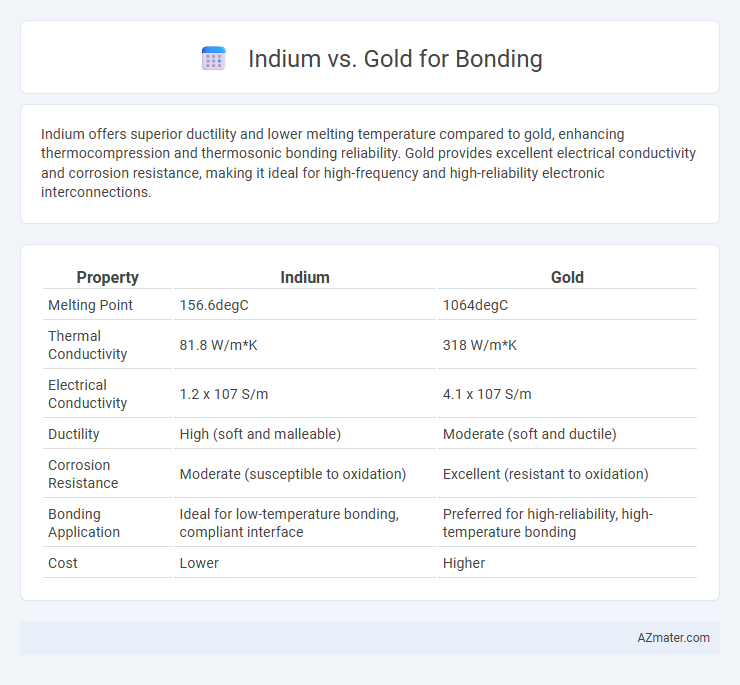Indium offers superior ductility and lower melting temperature compared to gold, enhancing thermocompression and thermosonic bonding reliability. Gold provides excellent electrical conductivity and corrosion resistance, making it ideal for high-frequency and high-reliability electronic interconnections.
Table of Comparison
| Property | Indium | Gold |
|---|---|---|
| Melting Point | 156.6degC | 1064degC |
| Thermal Conductivity | 81.8 W/m*K | 318 W/m*K |
| Electrical Conductivity | 1.2 x 107 S/m | 4.1 x 107 S/m |
| Ductility | High (soft and malleable) | Moderate (soft and ductile) |
| Corrosion Resistance | Moderate (susceptible to oxidation) | Excellent (resistant to oxidation) |
| Bonding Application | Ideal for low-temperature bonding, compliant interface | Preferred for high-reliability, high-temperature bonding |
| Cost | Lower | Higher |
Introduction to Metal Bonding in Electronics
Indium and gold are critical metals used in electronic bonding due to their excellent conductivity and solderability. Indium's low melting point and malleability make it ideal for applications requiring robust thermal or electrical connections with minimal stress. Gold offers superior corrosion resistance and reliable electrical performance, making it a preferred choice for high-reliability interconnects in advanced semiconductor packaging.
Overview of Indium Bonding Techniques
Indium bonding techniques utilize the metal's excellent ductility and low melting point to create reliable, hermetic seals in microelectronic and semiconductor applications. Indium forms strong, malleable bonds through thermo-compression, diffusion, or ultrasonic bonding methods, enabling superior thermal and electrical conductivity compared to traditional gold bonding. These properties make indium an ideal choice for sensitive devices requiring flexible interconnects and enhanced mechanical compliance.
Gold Bonding Methods Explained
Gold bonding methods utilize techniques such as thermocompression and thermosonic bonding, leveraging gold's excellent electrical conductivity and resistance to oxidation for reliable wire and ribbon connections in microelectronics. These processes create strong metallurgical bonds by applying heat, pressure, and sometimes ultrasonic energy to gold wire or tabs, ensuring low contact resistance and long-term stability. In comparison, indium bonding offers softer, more malleable joints suitable for sensitive components but lacks the robustness and established industry standards that gold bonding provides.
Physical Properties: Indium vs Gold
Indium exhibits a lower melting point of 156.6degC compared to gold's 1064degC, making it ideal for low-temperature bonding applications. Its softness and ductility provide excellent compliance and stress relief in thermal cycling environments, whereas gold offers superior hardness and electrical conductivity. Indium's higher malleability allows for better mechanical interlocking in microelectronic packaging, contrasting with gold's robust resistance to oxidation and corrosion.
Electrical Conductivity Comparison
Indium offers superior electrical conductivity compared to gold, with a conductivity of approximately 1.2 x 10^7 S/m, making it highly efficient for bonding applications requiring minimal electrical resistance. Gold, while slightly lower at around 4.1 x 10^7 S/m, provides excellent corrosion resistance and stable conductivity over time, which benefits long-term bonding reliability. The choice between indium and gold in bonding hinges on the balance between immediate conductivity performance and environmental stability.
Thermal Performance: Indium versus Gold
Indium offers superior thermal conductivity compared to gold, with values around 86 W/m*K versus gold's 318 W/m*K, facilitating efficient heat dissipation in high-power electronics. Indium's lower melting point (156.6degC) enables reliable thermal interface bonding without damaging temperature-sensitive components, while gold maintains structural integrity at higher temperatures with a melting point of 1064degC. The choice between indium and gold for bonding applications hinges on balancing optimal thermal performance, mechanical compliance, and operating environment temperature requirements.
Reliability and Durability in Bonding
Indium provides superior bonding reliability due to its excellent ductility and resistance to thermal fatigue, making it ideal for applications requiring long-term stability under thermal cycling. Gold bonds offer high corrosion resistance and stable electrical conductivity, enhancing durability in harsh environments. Compared to gold, indium's softness allows for stress absorption, reducing the likelihood of bond failure in flexible or vibration-prone conditions.
Cost Analysis: Indium vs Gold
Indium offers a significantly lower material cost compared to gold, making it a more economical choice for bonding in semiconductor and electronic applications. While gold exhibits superior conductivity and corrosion resistance, its high price and scarcity contribute to elevated overall bonding expenses. Indium's affordability, combined with adequate electrical and thermal performance, positions it as a cost-effective alternative for reliable bonding solutions.
Applications and Industry Use Cases
Indium bonding is preferred in semiconductor packaging and cryogenic sensor applications due to its excellent ductility and low melting point, enabling reliable thermal and electrical connections in delicate devices. Gold bonding dominates high-frequency electronics, medical implants, and aerospace industries, where its superior corrosion resistance and stable conductive properties ensure long-term performance and reliability. Both metals are critical in microelectronics but diverge in use cases based on their mechanical properties and environmental resilience.
Conclusion: Choosing the Right Metal for Bonding
Indium offers superior compliance and thermal stability, making it ideal for applications requiring flexible, high-reliability bonds, especially in cryogenics and electronics packaging. Gold provides excellent corrosion resistance and electrical conductivity, preferred for high-frequency and long-term stable connections in semiconductor devices. Selecting between indium and gold depends on specific performance requirements, cost constraints, and environmental conditions of the bonding application.

Infographic: Indium vs Gold for Bonding
 azmater.com
azmater.com